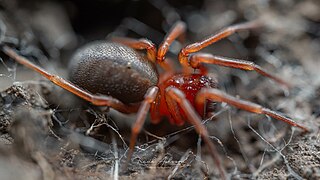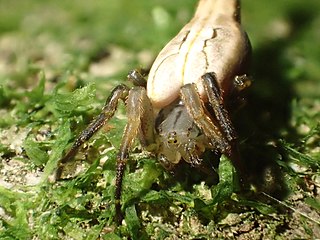
Paradictyna rufoflava is a spider of the genus Paradictyna endemic to New Zealand. It is a cribellate spider of the family Dictynidae.

Trite auricoma, commonly known as the golden-brown jumping spider, is a species of jumping spider endemic to New Zealand.

Waitkera is a genus of spiders in the family Uloboridae. It was first described in 1979 by Opell. As of 2021, it contains only one species, Waitkera waitakerensis, found in New Zealand.

Periegops suterii is a species of spider in the genus Periegops that is endemic to the South Island of New Zealand.

Backobourkia brouni,, or Broun's marbled orb-weaver, also often referred to by its synonym Backobourkia brounii, is a spider native to Australia and New Zealand.

Arachnura feredayi, the tailed forest spider, is endemic to New Zealand. it is known for the distinctive tapering body shape in females which are also much larger than males, and for producing vertical columns of eggsacs in the 12 o'clock position in their webs.

Sidymella angularis, is a species of crab spider endemic to New Zealand.
Cantuaria aperta is a species of trapdoor spider endemic to New Zealand.
Cantuaria cognata is a species of trapdoor spider endemic to New Zealand.
Cantuaria grandis is a species of trapdoor spider endemic to New Zealand.
Cantuaria pilama is a species of trapdoor spider endemic to New Zealand.
Cantuaria reducta is a species of trapdoor spider endemic to New Zealand.
Cantuaria sinclairi is a species of trapdoor spider endemic to New Zealand.
Cantuaria wanganuiensis a species of trapdoor spider endemic to New Zealand.

Stanwellia houhora is a species of Mygalomorph spider endemic to New Zealand.
Stanwellia media is a species of Mygalomorph spider endemic to New Zealand.

Stanwellia taranga is a species of Mygalomorph spider endemic to New Zealand.
Stanwellia tuna is a species of Mygalomorph spider endemic to New Zealand.

Adoxotoma forsteri is a species of Salticidae that is endemic to New Zealand.
Prasonica plagiata is a species of Araneidae that is endemic to New Zealand.











